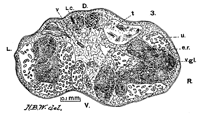Parasitology, Harold W. Manter Laboratory of

Studies from the University of Nebraska Zoological Laboratory
On the Parasites of the Lake Fish: Notes on the Structure and Life History of Distoma opacum, n. sp.
Date of this Version
8-1-1893
Abstract
This work was done while a member of the scientific corps sent out by the Michigan Fish Commission to begin an investigation of the biological conditions in the Great Lakes. The work in 1893 was carried on at New Baltimore, on Lake St. Clair. My thanks are due to the Michigan Board of Fish Commissioners for the many conveniences placed at my disposal in carrying out the investigations on fish parasites, of which this is one result. To Professor J. E. Reighard, director of the party, I owe much for his interest and hearty cooperation in all matters pertaining to this work.
In the first dog-fish (Amia calva L.) examined (August 2) the intestine just above the spiral valve yielded a large number (354) of specimens of a small Distoma, which is about the size and shape of a mustard seed. It seemed on examination to be a new species, and later study strengthened this opinion. My attention was, however, more particularly directed to it when ten days later I examined a specimen of the same fish which had been brought from Saint Clair Flats, opposite our laboratory. The number of this Distoma present was so great as to cover completely the wall of the intestine. They were removed by a pipette to a dish of normal salt solution (0.75 per cent.) and, after examination, preserved in a saturated solution of corrosive sublimate, in Kleinenberg's picrosulphuric acid, and in Flemming's chrom-osmo-acetic acid, about one-third in each. One of these lots counted later showed 1,023 individuals present. The fish just mentioned had enjoyed a meal of Cambarus propinquus, 26 of which were still easily recognizable in his stomach. I noticed at once in the crayfish, which had the cephalo-thorax crushed and in most cases its dorsal portion gone, a large number of small cysts, while around these cysts were occasional free Distomes, and in the stomach were to be found both cysts and free Distomes, whose identity with those in the crayfish and with the specimens from the intestine was afterwards established beyond a doubt. These results were communicated to the Society in a paper which was, however, read by title only.
During the latter part of August the work of examining the fish for parasites was entrusted to Mr. Dwight Lydell, an experienced and careful assistant of the Fish Commission, and from his record of two specimens of Amia examined August 31, I take the following: “One with tapeworms was feeding on small fish, the other on crawfish.” The parasites from" the other" were this Distoma, both free and enclosed in cysts, so that the source of the infection seemed clear.


Comments
From the Proceedings of the American Microscopical Society, Vol. XV, pp. 173-182. Sixteenth Annual Meeting, Madison, Wisconsin, 1893.